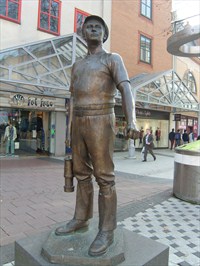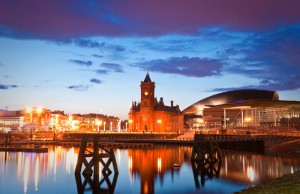
The Miner by local sculptor Robert Thomas, is a reminder of the sweat and blood that the city of Cardiff is built upon. It makes the point wonderfully well of how very different, and comparatively easy, our modern day life is.
Tim Williams CEO of The Committee for Sydney
Another key participant at the Capital City Vision Event, was Tim Williams – CEO of The Committee for Sydney. Tim, a proud Welshman, was formerly CEO of the Thames Gateway London Partnership where he made the Gateway in East London the key urban regeneration project for London and indeed the UK. Tim is recognised as one of the leading urban renewal thinkers and practitioners at work in the field, with an international reputation.
Tim’s brilliant speech focused on the future of cities. People are flocking to cities and most interestingly back to city centres. The dream of our parents and grand parents of living in suburbia is in full reverse. Thirty years ago inner cities had connotations of being dangerous, low quality slum districts but today more and more people want to live in the heart of cities. The easy access to amenities, connectivity and being able to conduct daily life in a simpler, lower cost way are some of the major drivers. These new urbanites offer many benefits to society as well, such as reduced carbon footprint as daily commutes are impacted and with people living in smaller city centre accommodation.
Bright Flight
These people are educated and seeking knowledge based jobs as well. This phenomenon is what the demographer William Frey has in mind when he says “A new image of urban America is in the making. What used to be white flight to the suburbs is turning into ‘bright flight’ to cities that have become magnets for aspiring young adults who see access to knowledge-based jobs, public transportation and a new city ambiance as an attraction.”
The point is to ensure you have some of what attracts ‘bright flight’: walkable urbanism.And it’s not just the young. Interestingly the baby boomers, who are now approaching retirement age, are seeking easier, lower cost, life styles with their larger homes in the suburbs now costing them more time and effort to maintain and heat. City centre living also reduces the need for cars. This means cities need efficient, good quality, public transportation systems as well as offering walkable urbanism.
Place Branding: The Drivers and Issues
My own speech in Cardiff focused on three aspects of developing a strong city brand. Firstly I looked at some of the drivers for city branding such as the attraction of tourists, inward investment as well as new tax paying residents. Place and city branding is one of the most complex marketing tasks that can be undertaken and has to involve a high degree of stakeholder contact. Identifying and involving the key stakeholders is central to any place branding strategy. Finally I looked at positioning, which goes to the very heart of place branding. Here I referenced my own work for the city of Stockholm and its positioning as The Capital of Scandinavia. The art of marketing is the art of branding. The art of branding is the art of positioning. What do you stand for and represent? I play a little game of asking people what one word they would use to describe a city. It’s one of the most challenging questions to answer for any brand and goes to the heart of positioning.
Place branding has grown enormously in the last ten years and as one place markets itself, very other place has to. Many of the disciplines of consumer marketing apply however to place branding. Like a traditional brand, places need to develop long term strategies. These should have a ten and twenty year perspective and not change with every political cycle. This means politicians need to be engaged early on and the strategy needs to have cross political party agreement to have a long term future. Stockholm’s has been in place now over ten years and has been through different political administrations successfully.
Building strong place brands can have a remarkable impact on cities. Just take the case of Barcelona. Today it is seen as one of the world’s most successful cities. However, it was all very different forty years ago. In the 1975 series Fawlty Towers Manuel, the hapless Spanish waiter who lived in fear of Mr Fawlty, was cast as coming from Barcelona. His home town was chosen with great care – as at that stage Barcelona was considered by many foreigners to be a run down, dirty, industrial black hole. It wasn’t until the death of Franco in 1975, that a new regional focus was put in place to get the city back on a path to regeneration. One of the key springboards in the strategy was the winning, and hugely successful staging of, the 1992 Olympic games, Barcelona is one of the few destinations to have run an Olympics at a profit. More than most places, the case of Barcelona proves that it is possible to turn around the fortunes of a city given the right strategy, a high degree of stakeholder involvement, focus and – most importantly – investment.
The Barcelona case was I felt relevant to my Cardiff presentation. Cardiff has been through a remarkable transformation since my youth. It’s already impressive. But the UK needs to embrace a more decentralised approach. London still dominates but turning the UK’s regional cities into new economic power houses would have tremendous benefits for the entire UK economy.
I was asked what one word I would use to describe Cardiff and spontaneously I replied passion. It’s a city with genuine passion and pride. You can feel it in meeting the local people and politicians. Lagom? Certainly not. Cardiff is a place that deserves to succeed and stand out. As the Capital city of Wales it also has a gravitas that most cities can’t match.
Cardiff has yet more potential to offer and I believe the best is yet to come. Granny Stubbs, my Welsh grandmother, would be proud.
—————————————————————– Watch an extract from the Capital City Vision speech here:
